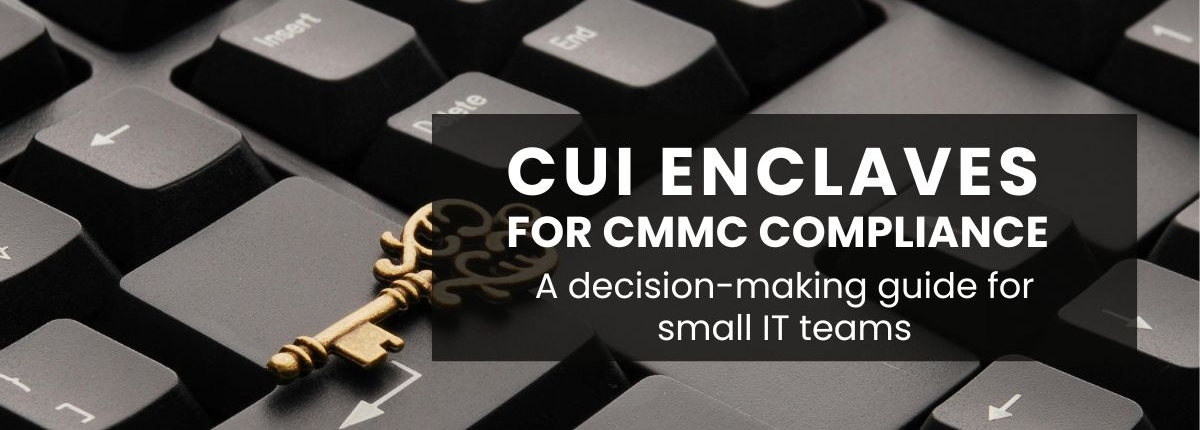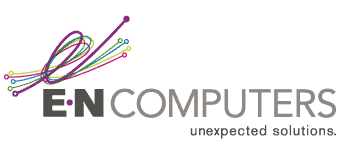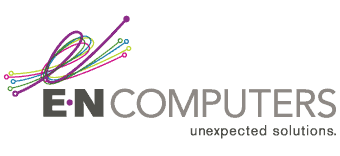
 by Mustafa Mukhtar, MBA, ITIL
by Mustafa Mukhtar, MBA, ITIL
Consultant/Content Contributor, E-N Computers
20+ years of experience in IT management, project planning, enterprise systems and user support
CUI enclaves can simplify CMMC compliance. By isolating Controlled Unclassified Information in a secure environment, enclaves can reduce risk and narrow your compliance scope. But they’re not right for every organization. This guide will help you decide whether a CUI enclave fits your business and IT environment.
A CUI enclave is a segregated IT environment designed to contain and protect CUI. Instead of applying strict security requirements across an entire organization, an enclave limits CUI access to a specific system or group of users.
A CUI enclave is not a one-size-fits-all solution. It requires careful planning, implementation, and ongoing maintenance to meet compliance requirements.
QUICK ANSWER:
Is a CUI enclave the fastest way to achieve CMMC compliance?
It can be — especially if your CUI is handled by a small group and you use a cloud-based or turnkey solution. But for complex operations or heavy collaboration, it might not be the best fit.
How businesses are setting up enclaves
Here are the most common ways organizations are implementing enclaves today:
Virtual desktop infrastructure (VDI)
With a virtual desktop infrastructure, users access a secure, isolated desktop environment where CUI is processed and stored. This approach centralizes security and simplifies compliance.
VDI solutions like Citrix or VMware Horizon provide a safe, remote desktop environment where CUI is processed and stored. Users access the VDI from their endpoint devices, but all data remains in the controlled virtual environment, reducing compliance scope. VDI is ideal for businesses needing centralized security and remote workforce support.
For more details on using VDI for CMMC compliance, see our article Azure Virtual Desktop enclaves aren’t a compliance silver bullet – here’s why.
On-premises secure server
An on-premises secure server is a dedicated, physically separated network segment, often with physically isolated or firewall-isolated servers with restricted access. With this approach, CUI remains isolated from general IT operations. Physical security measures, such as badge access and surveillance, further restrict unauthorized access. This works best for organizations with high security needs and existing on-prem infrastructure.
Microsoft GCC High & AWS GovCloud
Microsoft and AWS offer cloud-based enclave solutions that provide preconfigured government-compliant security controls, eliminating the need for on-prem infrastructure and reducing maintenance overhead. Either is a strong option for businesses already leveraging cloud services or with distributed teams. Businesses needing to achieve CMMC quickly can deploy a fully cloud-hosted enclave.
Third-party enclave providers
Some vendors like Cuick Trac and PreVeil offer pre-built, turnkey enclave solutions. These pre-configured CUI enclaves reduce setup complexity while maintaining compliance. A pre-built enclave can be attractive for businesses who don’t have in-house security expertise.
These solutions are designed to make CMMC compliance easier, with features like secure cloud storage, encryption, role-based access, and built-in auditing. They can save time and reduce the need for in-house skill. But working with third-party vendors can raise questions about who controls your data and what it might cost you over time. And they’re not one-size-fits all. Custom-built enclaves offer more flexibility and control, though they require a bigger investment.
Comparing CUI Enclave Deployment Options
| Type of enclave | VDI | On-Premises | Cloud | 3rd-Party |
|---|---|---|---|---|
| Primary Benefit | Centralized, secure remote access | Full physical control and isolation | Fast deployment with prebuilt compliance features | Fast, simplified setup with minimal in-house effort |
| Ideal For | Remote teams, info workers, centralized workflows | Organizations with high internal IT resources | Businesses needing quick compliance, cloud-ready environments | Small teams without IT staff, looking for a turnkey solution |
| Setup & Deployment | Moderate setup time, depends on vendor and internal infrastructure | Longest setup time, complex planning | Fastest if already using Microsoft or AWS ecosystem | Very fast – typically plug-and-play |
| Maintenance | Requires in-house or managed IT support | Fully managed in-house | Managed by cloud provider | Managed by vendor with optional support contracts |
| Cost Profile | Moderate to high – includes licenses and possible duplication of systems | High upfront investment; lower recurring cost | Subscription-based; predictable monthly cost | Subscription or bundled cost; may rise with user count or features |
| Customization | High, especially with internal IT staff | Very high – full control of stack | Moderate – depends on provider and services selected | Low – fixed feature sets, limited ability to customize |
| Security Considerations | Data stays in secure hosted environment, limited risk if configured properly | Strong physical/logical control; high responsibility | High compliance standards; inherits provider’s certifications | Vendor-managed security; some risk with shared infrastructure |
| IT Expertise Needed | Moderate – need to manage sessions, identity, policies | High – full ownership of configuration and updates | Low to moderate – depends on vendor involvement | Low – designed for non-technical teams |
When CUI enclaves work best
Knowing whether any of these CUI enclave options are the right fit for you depends on how your business handles sensitive data, how your teams work, and how much control you have over users and systems.
Example use cases that fit well with enclaves would include:
- software development teams using secure code repositories
- CAD modeling workflows where design files remain within the enclave
- professional services firms (legal, accounting, consulting) handling sensitive client data.
We’ll break down why these types of businesses are a good fit. Here are four business settings where enclaves tend to work well.
CUI is limited to a small subset of users
If only a handful of employees handle CUI, an enclave can isolate that data and reduce the compliance scope. Remember, you’re not isolating CUI to a specific machine — you’re isolating it to specific people. An enclave depends more on who has access than where the data resides.
You’re not isolating CUI to a specific machine — you’re isolating it to specific people. An enclave depends more on who has access than where the data resides.
For example, a company is a 10-person CNC machine shop where only two employees handle DoD contracts involving CUI. They’ve built a basic enclave using a secure cloud workspace that only those two staff members can access. Because CUI is handled by a small, well-defined group, the enclave approach is effective and efficient for them.
The business has well-defined workflows
If CUI can be neatly contained within specific applications or processes, an enclave simplifies security management. Consistent workflows make it easier to maintain compliance boundaries.
Employees are mostly information technology workers
Engineers, consultants, and software developers and others who perform most of their work at a computer can adapt more easily to the remote-access models enclaves often require.
You can strictly control access
Organizations that can tightly control and enforce who accesses CUI benefit most from an enclave approach. The technology is only as secure as the access policies and training of the people who use it. Enclave users often need to be tech-savvy, capable of managing multi-step login processes and navigating remote or virtual desktop environments.
When a CUI enclave won’t work
In some cases, trying to implement an enclave can add more complexity than it solves. Here are situations where an enclave may not be the best option.
CUI is deeply embedded in daily operations
Businesses where CUI is spread across multiple departments, emails, or shared platforms may struggle with containment.
An example would be a mid-sized aerospace supplies company where engineers, sales, procurement, and customer service teams all touch CUI in some form, from technical drawings to quotes to emails. Because CUI touches so many parts of your workflow, trying to separate it into an enclave can end up costing more than it’s worth.
You have to collaborate
If your team regularly shares CUI with outside partners or across departments, an enclave can slow things down and get in the way.
You’re a single-person business or small manufacturer
Small teams handling CUI directly in core operations (e.g., machine shops) may find a full organizational approach simpler than trying to isolate CUI into a separate enclave.
Common misconceptions about CUI enclaves
Enclaves are often seen as a silver bullet for simplifying CMMC compliance, but that perception doesn’t always match reality. While enclaves can be powerful tools, there are several misconceptions about what they do, how much they cost, and how easily they can fit into existing business operations. Let’s break down a few of the most common myths.
“CUI enclaves always reduce compliance costs.”
Not necessarily. While an enclave can reduce the number of systems and users that fall under the scope of CMMC compliance, it often introduces new layers of cost and complexity, including:
- Initial setup: Building a secure enclave (whether cloud or on-prem) requires investment in infrastructure, security controls, and implementation planning.
- Ongoing operational adjustments: Employees must adapt workflows so that all CUI is processed, stored, and transmitted within the enclave. This often means learning new systems, switching applications, or following stricter processes. Maintaining the enclave requires continuous monitoring, maintenance, patching, and regular security audits.
- Access management overhead: Enforcing access restrictions without interrupting business processes takes time and planning — especially in collaborative environments.
- Compliance drift: If the enclave isn’t carefully integrated into business operations, users may revert to old habits that violate compliance boundaries.
For example, a small aerospace parts supplier implemented a VDI-based enclave but failed to align it with their production floor workflows.
Engineers and machinists found the system slow and cumbersome for accessing technical drawings, so they started saving files to USB drives or emailing them outside the enclave to keep projects moving or forwarding CUI-related files to personal email or downloading them onto non-compliant devices. This not only undermined compliance but increased the organization’s risk exposure.
- Future CMMC changes: CMMC is still evolving, and enclave requirements may change. Businesses that build rigid or overly complex enclaves could face expensive overhauls in the future. Investing in scalable, well-documented architecture — and maintaining user engagement — is key to long-term viability.
- Hidden costs: Many businesses underestimate the not-so-obvious costs of enclave adoption.
For example, you’re effectively managing two environments – a secure enclave and your legacy IT systems — which can double infrastructure and support costs.Your licensing and subscriptions can add up quickly, particularly if you’re using turnkey solutions that bundle templates, automation tools, and cloud licenses. This can increase complexity, especially for organizations that lack the internal IT expertise to maintain a separate enclave and integrate it smoothly with existing operations.
In short, enclaves reduce compliance scope — but that doesn’t always mean they reduce your budget or your burden.
“An enclave fully solves CMMC compliance issues”
No. Even with an enclave, the rest of your IT infrastructure must still be protected against cyber threats. Plus, implementing an enclave doesn’t exempt a company from all CMMC requirements, only those specific to handling CUI.
For example, a company using an enclave for CUI storage must still secure email systems to prevent phishing attacks targeting employees with access.
Major implementation challenges for CUI enclaves
Setting up a CUI enclave sounds straightforward, but the real-world execution can be tricky. Even with the right tools in place, you can easily make mistakes that lead to security gaps or extra work. Here are four common challenges that trip up organizations during implementation.
Scoping the enclave
You’ll need to define what data, systems, users, and workflows fall within the enclave. A poorly scoped enclave can lead to compliance gaps, duplicate work, or even a false sense of security.
One of the common scoping failures is misconfigured file sync tools. For example, some organizations use secure platforms like PreVeil but overlook that it syncs files to users’ local computers. While the cloud copy might meet CUI protection requirements, the synced local version may not — effectively placing sensitive data outside the secure boundary.
Another common scoping failure is ignoring peripheral users or systems. A company might believe it has secured its 20-person compliance team but fail to account for the 180 other employees who access, handle, or even view CUI through shared drives, emails, or collaborative tools. Without a clear definition of which users and devices are in or out of scope, you increase your attack surface — and your audit risk.
Defining processes
You’ll need to separate business operations into CUI-related and non-CUI-related activities to keep CUI contained.
Access control & identity management
You’ll need to implement strict role-based access controls so only authorized users can access CUI.
Integration with existing IT Systems
You can’t move data in and out of the enclave without following security protocols to avoid accidental CUI exposure.
Next steps
If you’re considering a CUI enclave for CMMC compliance, here are some recommended next steps:
- Assess your CUI scope: Identify where CUI exists in your organization and how it’s used.
- Evaluate security needs: Determine whether an enclave or broader security approach is best for your workflows.
- Develop an implementation plan: Define the architecture, access controls, and monitoring processes for your enclave.
- Train employees: Educate staff about new processes and security requirements.
- Monitor and adjust: Continuously assess and improve security measures to align with evolving CMMC regulations.
- Consult compliance experts: Get help from your CMMC specialists to meet certification requirements.
Need help with CUI enclaves? Grab a complimentary consulting session to discuss your unique needs and explore whether a CUI enclave is the right solution for your business. As an MSP, MSSP, and CMMC compliance expert, E-N Computers has helped many businesses assess their IT environment and implement security strategies that meet compliance requirements.
We specialize in planning, building, and supporting CUI enclaves so they are properly scoped, securely configured, and fully integrated into your IT infrastructure.
Our team can help with:
- Designing and implementing a secure enclave tailored to your business needs.
- Managing and maintaining enclave security through ongoing monitoring and compliance updates.
- Providing IT support and cybersecurity services beyond the enclave to protect your entire organization.
- Guiding you through the CMMC certification process, guaranteeing readiness for audits and long-term compliance.
Complimentary review with an experienced engineer
Are you ready for CMMC?

Get a free strategic consultation to start or streamline your journey toward CMMC compliance.
More CMMC Resources
If you’re looking for CMMC consulting services for your small business
- Case Study: Virginia Government Contractor Nears CMMC Compliance
- CMMC Consulting Services for SMBs
- CMMC Gap Analysis
- Best CMMC consultants
If you need to better understand CMMC requirements:
- The Ultimate Guide to CMMC
- The Ultimate Guide to DFARS and NIST 800-171 (in plain English)
- What is FCI and should I worry about it?
- What is CUI and should I worry about it?
- CMMC compliance deadlines: Key dates and what they mean
If you’re looking for CMMC tools and training:
- We found the best GRC tool for CMMC
- What is Microsoft GCC High and do I need it?
- Best CMMC training resources
- CMMC Level 1 guide as audio book
- CMMC Level 2 guide as audio book
If you’re looking for a Registered Practitioner Organization:
- Best CMMC RPOs near Washington, DC
- Best Virginia Registered Practitioner Organizations
- What are CMMC Registered Practitioners and do I need one?
If you’re looking for a CMMC assessor:
If you’re looking for information about CMMC that is targeted toward smaller businesses:

Industries
Locations
Waynesboro, VA
Corporate HQ
215 Fifth St.
Waynesboro, VA 22980
Sales: 540-217-6261
Service: 540-885-3129
Accounting: 540-217-6260
Fax: 703-935-2665
Washington D.C.
1126 11th ST. NW
Suite 603
Washington, DC 20001-4366
Sales: 202-888-2770
Service: 866-692-9082
VA DCJS # 11-6604
Locations
Harrisonburg, VA
45 Newman Ave.
Harrisonburg, VA 22801
Sales: 540-569-3465
Service: 866-692-9082
Richmond, VA
3026A W. Cary St.
Richmond, VA 23221
Sales: 804-729-8835
Service: 866-692-9082
